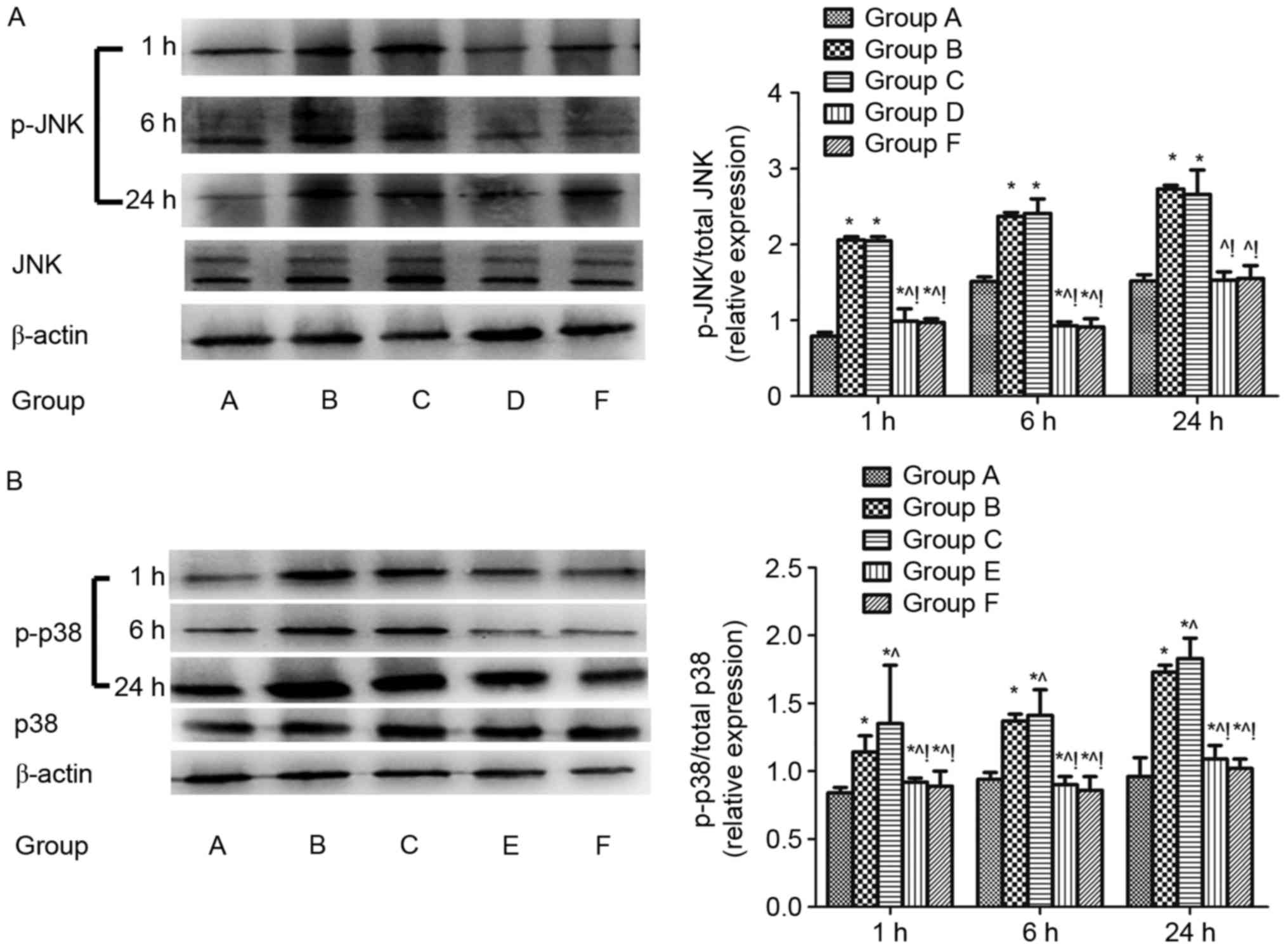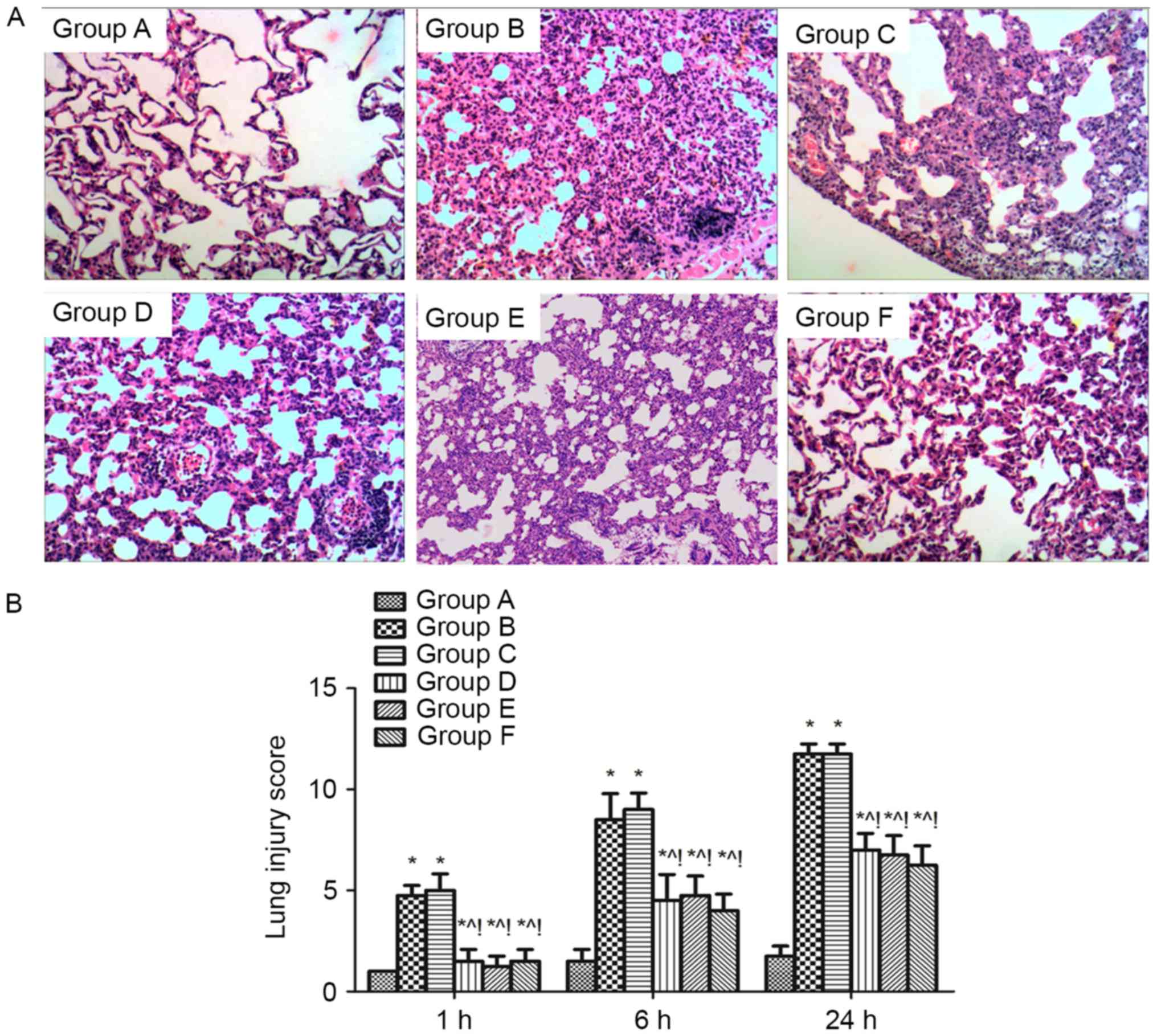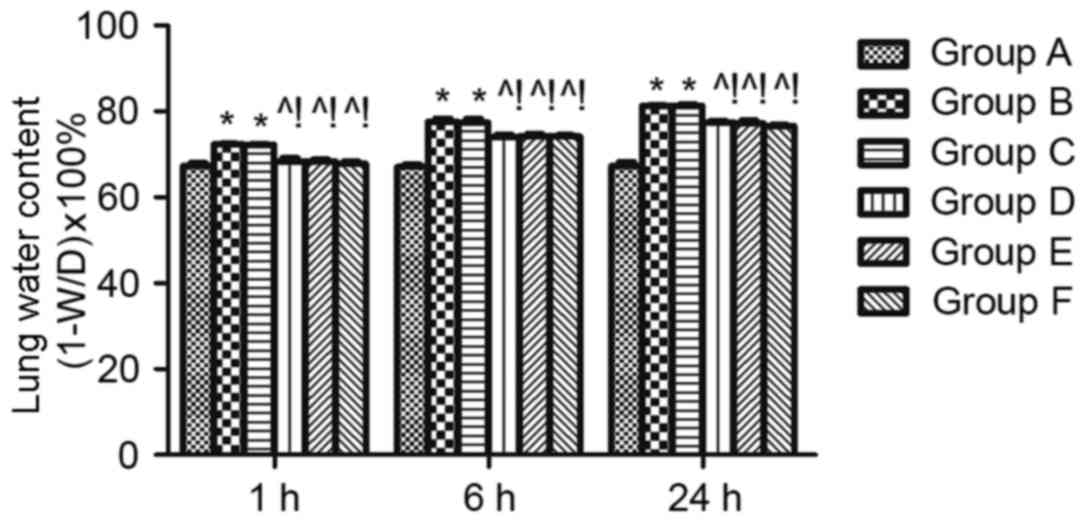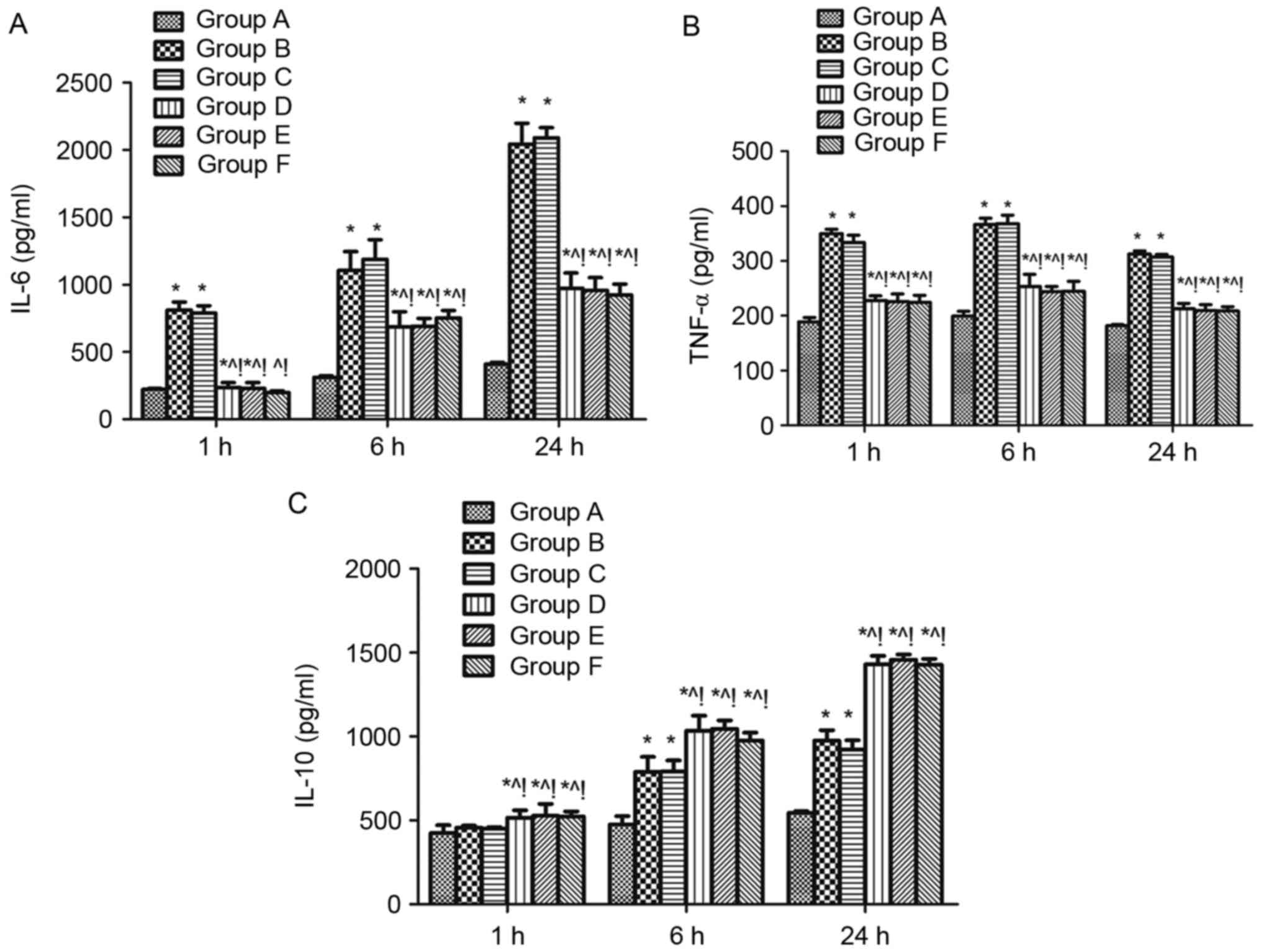|
1
|
Ware LB and Matthay MA: The acute
respiratory distress syndrome. N Engl J Med. 342:1334–1349. 2000.
View Article : Google Scholar : PubMed/NCBI
|
|
2
|
Rubenfeld GD, Caldwell E, Peabody E,
Weaver J, Martin DP, Neff M, Stern EJ and Hudson LD: Incidence and
outcomes of acute lung injury. N Engl J Med. 353:1685–1693. 2005.
View Article : Google Scholar : PubMed/NCBI
|
|
3
|
Goss CH, Brower RG, Hudson LD and
Rubenfeld GD; ARDS Network, : Incidence of acute lung injury in the
United States. Crit Care Med. 31:1607–1611. 2003. View Article : Google Scholar : PubMed/NCBI
|
|
4
|
Hudson LD, Milberg JA, Anardi D and
Maunder RJ: Clinical risks for development of the acute respiratory
distress syndrome. Am J Respir Crit Care Med. 151:293–301. 1995.
View Article : Google Scholar : PubMed/NCBI
|
|
5
|
Sevransky JE, Martin GS, Shanholtz C,
Mendez-Tellez PA, Pronovost P, Brower R and Needham DM: Mortality
in sepsis versus non-sepsis induced acute lung injury. Crit Care.
13:R1502009. View
Article : Google Scholar : PubMed/NCBI
|
|
6
|
de Luis Cabezon N, Sánchez Castro I,
Uriarte UX Bengoetxea, Casanova MP Rodrigo, García Peña JM and
Celorrio L Aguilera: Acute respiratory distress syndrome: A review
of the Berlin definition. Rev Esp Anestesiol Reanim. 61:319–327.
2014.(In Spanish). PubMed/NCBI
|
|
7
|
Kono H and Rock KL: How dying cells alert
the immune system to danger. Nat Rev Immunol. 8:279–289. 2008.
View Article : Google Scholar : PubMed/NCBI
|
|
8
|
Iyer SS, Pulskens WP, Sadler JJ, Butter
LM, Teske GJ, Ulland TK, Eisenbarth SC, Florquin S, Flavell RA,
Leemans JC and Sutterwala FS: Necrotic cells trigger a sterile
inflammatory response through the Nlrp3 inflammasome. Proc Natl
Acad Sci USA. 106:pp. 20388–932. 2009; View Article : Google Scholar : PubMed/NCBI
|
|
9
|
Strassheim D, Park JS and Abraham E:
Sepsis: Current concepts in intracellular signaling. Int J Biochem
Cell Biol. 34:1527–1533. 2002. View Article : Google Scholar : PubMed/NCBI
|
|
10
|
Arthur JS and Ley LC: Mitogen-activated
protein kinases in innate immunity. Nat Rev Immunol. 13:679–692.
2013. View
Article : Google Scholar : PubMed/NCBI
|
|
11
|
Kyriakis JM and Avruch J: Mammalian
mitogen-activated protein kinase signal transduction pathways
activated by stress and inflammation. Physiol Rev. 81:807–869.
2001.PubMed/NCBI
|
|
12
|
Ahmed AU, Williams BR and Hannigan GE:
Transcriptional Activation of Inflammatory Genes: Mechanistic
insight into selectivity and diversity. Biomolecules. 5:3087–3111.
2015. View Article : Google Scholar : PubMed/NCBI
|
|
13
|
Cohen P: Targeting protein kinases for the
development of anti-inflammatory drugs. Curr Opin Cell Biol.
21:317–324. 2009. View Article : Google Scholar : PubMed/NCBI
|
|
14
|
Dar AC and Shokat KM: The evolution of
protein kinase inhibitors from antagonists to agonists of cellular
signaling. Annu Rev Biochem. 80:769–795. 2011. View Article : Google Scholar : PubMed/NCBI
|
|
15
|
Kim SJ, Baek KS, Park HJ, Jung YH and Lee
SM: Compound 9a, a novel synthetic histone deacetylase inhibitor,
protects against septic injury in mice by suppressing MAPK
signalling. Br J Pharmacol. 173:1045–1057. 2016. View Article : Google Scholar : PubMed/NCBI
|
|
16
|
Huang X, Kong G, Li Y, Zhu W, Xu H, Zhang
X, Li J, Wang L, Zhang Z, Wu Y, et al: Decitabine and 5-azacitidine
both alleviate LPS induced ARDS through
anti-inflammatory/antioxidant activity and protection of glycocalyx
and inhibition of MAPK pathways in mice. Biomed Pharmacother.
84:447–453. 2016. View Article : Google Scholar : PubMed/NCBI
|
|
17
|
Peng S, Hang N, Liu W, Guo W, Jiang C,
Yang X, Xu Q and Sun Y: Andrographolide sulfonate ameliorates
lipopolysaccharide-induced acute lung injury in mice by
down-regulating MAPK and NF-κB pathways. Acta Pharm Sin B.
6:205–211. 2016. View Article : Google Scholar : PubMed/NCBI
|
|
18
|
Xu X, Liu N, Zhang YX, Cao J, Wu D, Peng
Q, Wang HB and Sun WC: The protective effects of HJB-1, a
derivative of 17-Hydroxy-Jolkinolide B, on LPS-induced acute
distress respiratory syndrome mice. Molecules. 21:772016.
View Article : Google Scholar : PubMed/NCBI
|
|
19
|
Kong G, Huang X, Wang L, Li Y, Sun T, Han
S, Zhu W, Ma M, Xu H, Li J, et al: Astilbin alleviates LPS-induced
ARDS by suppressing MAPK signaling pathway and protecting pulmonary
endothelial glycocalyx. Int Immunopharmacol. 36:51–58. 2016.
View Article : Google Scholar : PubMed/NCBI
|
|
20
|
Zhao H, Zhao M, Wang Y, Li F and Zhang Z:
Glycyrrhizic acid prevents sepsis-induced acute lung injury and
mortality in rats. J Histochem Cytochem. 64:125–137. 2016.
View Article : Google Scholar : PubMed/NCBI
|
|
21
|
Shen L, Mo H, Cai L, Kong T, Zheng W, Ye
J, Qi J and Xiao Z: Losartan prevents sepsis-induced acute lung
injury and decreases activation of nuclear factor kappaB and
mitogen-activated protein kinases. Shock. 31:500–506. 2009.
View Article : Google Scholar : PubMed/NCBI
|
|
22
|
Otero-Antón E, González-Quintela A,
López-Soto A, López-Ben S, Llovo J and Pérez LF: Cecal ligation and
puncture as a model of sepsis in the rat: Influence of the puncture
size on mortality, bacteremia, endotoxemia and tumor necrosis
factor alpha levels. Eur Surg Res. 33:77–79. 2001. View Article : Google Scholar : PubMed/NCBI
|
|
23
|
Mrozek JD, Smith KM, Bing DR, Meyers PA,
Simonton SC, Connett JE and Mammel MC: Exogenous surfactant and
partial liquid ventilation: Physiologic and pathologic effects. Am
J Respir Crit Care Med. 156:1058–1065. 1997. View Article : Google Scholar : PubMed/NCBI
|
|
24
|
Dolinay T, Kim YS, Howrylak J, Hunninghake
GM, An CH, Fredenburgh L, Massaro AF, Rogers A, Gazourian L,
Nakahira K, et al: Inflammasome-regulated cytokines are critical
mediators of acute lung injury. Am J Respir Crit Care Med.
185:1225–1234. 2012. View Article : Google Scholar : PubMed/NCBI
|
|
25
|
Matthay MA, Zimmerman GA, Esmon C,
Bhattacharya J, Coller B, Doerschuk CM, Floros J, Gimbrone MA Jr,
Hoffman E, Hubmayr RD, et al: Future research directions in acute
lung injury: summary of a National Heart, Lung and Blood Institute
working group. Am J Respir Crit Care Med. 167:1027–1035. 2003.
View Article : Google Scholar : PubMed/NCBI
|
|
26
|
Wu H, Zhao G, Jiang K, Chen X, Zhu Z, Qiu
C, Li C and Deng G: Plantamajoside ameliorates
lipopolysaccharide-induced acute lung injury via suppressing NF-κB
and MAPK activation. Int Immunopharmacol. 35:315–322. 2016.
View Article : Google Scholar : PubMed/NCBI
|
|
27
|
Lee JH, Ko HJ, Woo ER, Lee SK, Moon BS,
Lee CW, Mandava S, Samala M, Lee J and Kim HP: Moracin M inhibits
airway inflammation by interrupting the JNK/c-Jun and NF-κB
pathways in vitro and in vivo. Eur J Pharmacol. 783:64–72. 2016.
View Article : Google Scholar : PubMed/NCBI
|
|
28
|
Newton K and Dixit VM: Signaling in innate
immunity and inflammation. Cold Spring Harb Perspect Biol. 4:pii:
a0060492012. View Article : Google Scholar
|
|
29
|
Kawai T and Akira S: The role of
pattern-recognition receptors in innate immunity: Update on
Toll-like receptors. Nat Immunol. 11:373–384. 2010. View Article : Google Scholar : PubMed/NCBI
|
|
30
|
Medzhitov R and Horng T: Transcriptional
control of the inflammatory response. Nat Rev Immunol. 9:692–703.
2009. View
Article : Google Scholar : PubMed/NCBI
|
|
31
|
Pizzino G, Bitto A, Pallio G, Irrera N,
Galfo F, Interdonato M, Mecchio A, De Luca F, Minutoli L, Squadrito
F and Altavilla D: Blockade of the JNK signalling as a rational
therapeutic approach to modulate the early and late steps of the
inflammatory cascade in polymicrobial sepsis. Mediators Inflamm.
2015:5915722015. View Article : Google Scholar : PubMed/NCBI
|
|
32
|
Zhou H, Bian D, Jiao X, Wei Z, Zhang H,
Xia Y, He Y and Dai Y: Paeoniflorin protects against
lipopolysaccharide-induced acute lung injury in mice by alleviating
inflammatory cell infiltration and microvascular permeability.
Inflamm Res. 60:981–990. 2011. View Article : Google Scholar : PubMed/NCBI
|
|
33
|
Zhu X, Zou Y, Wang B, Zhu J, Chen Y, Wang
L, Li J and Deng X: Blockade of CXC chemokine receptor 3 on
endothelial cells protects against sepsis-induced acute lung
injury. J Surg Res. 204:288–296. 2016. View Article : Google Scholar : PubMed/NCBI
|
|
34
|
Rahman A and Fazal F: Blocking NF-κB: An
inflammatory issue. Proc Am Thorac Soc. 8:pp. 497–503. 2011;
View Article : Google Scholar : PubMed/NCBI
|
|
35
|
McKenna S and Wright CJ: Inhibiting
IκBβ-NFκB signaling attenuates the expression of select
pro-inflammatory genes. J Cell Sci. 128:2143–2155. 2015. View Article : Google Scholar : PubMed/NCBI
|
|
36
|
Lee IT and Yang CM: Inflammatory
signalings involved in airway and pulmonary diseases. Mediators
Inflamm. 2013:7912312013. View Article : Google Scholar : PubMed/NCBI
|
|
37
|
Lai JL, Liu YH, Liu C, Qi MP, Liu RN, Zhu
XF, Zhou QG, Chen YY, Guo AZ and Hu CM: Indirubin Inhibits
LPS-induced inflammation via TLR4 abrogation mediated by the NF-kB
and MAPK signaling pathways. Inflammation. 40:1–12. 2017.
View Article : Google Scholar : PubMed/NCBI
|
|
38
|
Guo X, Gerl RE and Schrader JW: Defining
the involvement of p38alpha MAPK in the production of anti- and
proinflammatory cytokines using an SB 203580-resistant form of the
kinase. J Biol Chem. 278:22237–22242. 2003. View Article : Google Scholar : PubMed/NCBI
|
|
39
|
Jeong HJ, Na HJ, Hong SH and Kim HM:
Inhibition of the stem cell factor-induced migration of mast cells
by dexamethasone. Endocrinology. 144:4080–4086. 2003. View Article : Google Scholar : PubMed/NCBI
|
|
40
|
Schafer PH, Wang L, Wadsworth SA, Davis JE
and Siekierka JJ: T cell activation signals up-regulate p38
mitogen-activated protein kinase activity and induce TNF-alpha
production in a manner distinct from LPS activation of monocytes. J
Immunol. 162:659–568. 1999.PubMed/NCBI
|
|
41
|
Beyaert R, Cuenda A, Berghe W Vanden,
Plaisance S, Lee JC, Haegeman G, Cohen P and Fiers W: The p38/RK
mitogen-activated protein kinase pathway regulates interleukin-6
synthesis response to tumor necrosis factor. EMBO J. 15:1914–1923.
1996.PubMed/NCBI
|
|
42
|
Foey AD, Parry SL, Williams LM, Feldmann
M, Foxwell BM and Brennan FM: Regulation of monocyte IL-10
synthesis by endogenous IL-1 and TNF-alpha: Role of the p38 and
p42/44 mitogen-activated protein kinases. J Immunol. 160:920–928.
1998.PubMed/NCBI
|
|
43
|
Koprak S, Staruch MJ and Dumont FJ: A
specific inhibitor of the p38 mitogen activated protein kinase
affects differentially the production of various cytokines by
activated human T cells: Dependence on CD28 signaling and
preferential inhibition of IL-10 production. Cell Immunol.
192:87–95. 1999. View Article : Google Scholar : PubMed/NCBI
|
|
44
|
Yu X, Yu S, Chen L, Liu H, Zhang J, Ge H,
Zhang Y, Yu B and Kou J: Tetrahydroberberrubine attenuates
lipopolysaccharide-induced acute lung injury by down-regulating
MAPK, AKT, and NF-κB signaling pathways. Biomed Pharmacother.
82:489–497. 2016. View Article : Google Scholar : PubMed/NCBI
|
|
45
|
Jeong HW, Hsu KC, Lee JW, Ham M, Huh JY,
Shin HJ, Kim WS and Kim JB: Berberine suppresses proinflammatory
responses through AMPK activation in macrophages. Am J Physiol
Endocrinol Metab. 296:E955–E964. 2009. View Article : Google Scholar : PubMed/NCBI
|
|
46
|
Yeh CC, Kao SJ, Lin CC, Wang SD, Liu CJ
and Kao ST: The immunomodulation of endotoxin-induced acute lung
injury by hesperidin in vivo and in vitro. Life Sci. 80:1821–1831.
2007. View Article : Google Scholar : PubMed/NCBI
|
|
47
|
Singleton KD, Beckey VE and Wischmeyer PE:
Glutamine prevents activation of NF-kappaB and stress kinase
pathways, attenuates inflammatory cytokine release, and prevents
acute respiratory distress syndrome (ARDS) following sepsis. Shock.
24:583–589. 2005. View Article : Google Scholar : PubMed/NCBI
|
|
48
|
Yang HT, Papoutsopoulou S, Belich M,
Brender C, Janzen J, Gantke T, Handley M and Ley SC: Coordinate
regulation of TPL-2 and NF-κB signaling in macrophages by NF-κB1
p105. Mol Cell Biol. 32:3438–3451. 2012. View Article : Google Scholar : PubMed/NCBI
|













